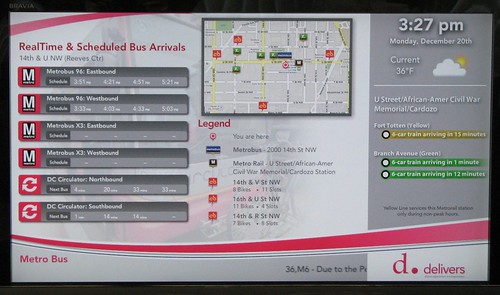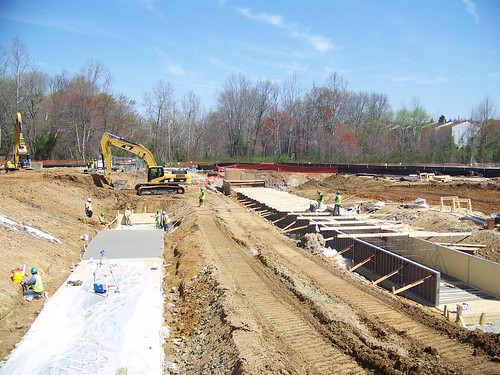I have a hard time creating such lists these days, because frankly, it's hard to step back and look at everything, plus I am the first to admit that I have particular interests and while I try to be objective, I can't be fully objective. The previous entry cited the Washington Post's
roundup by Dr. Gridlock of the top ten transportation issues of 2010:
1. Snow cleanup
2. Metro fare increases
3. leadership turmoil for WMATA
4. Tysons traffic
5. Metro bag inspections
6. Busted escalators
7. DC bike lanes
8. Rockville Pike Interchange
9. Fairfax County Parkway Extension
10. Commuter Train Troubles
I am going to add a few more items, recognizing I could never have done this without Dr. Gridlock's initial listing. This list is not rank-ordered, but numbered only in terms of additions to Dr. Gridlock's initial list of ten items.
11. As mentioned in the previous entry, Alexandria's passing a transit impact tax on property to build the infill subway station at Potomac Yard is pretty important, as is their consideration of levying transportation impact taxes on commercial property.
Related to this would be the ongoing success of the development of the NoMA district in DC, which is anchored by WMATA's first "infill" station at "New York Avenue" (really it's at 1st and M Streets NE, and at Florida Avenue and N Street (kind of)).
12. Continued densification in the suburbs, as reflected in the plans to intensely redevelop Tysons Corner in Virginia and White Flint in Montgomery County, Maryland, along sustainable transportation principles (working to capture more trips by walking, biking, and transit). You can think of this as next generation transportation oriented development, if Arlington County's Wilson Blvd. would be considered first generation.
Rockville Pike today (Washington Post image by Bill O'Leary)
Rockville Pike as rendered in the future White Flint plan (Rendering from the White Flint Partnership)
13. A recognition, maybe 5 years too late, of the negative transportation impacts of BRAC related military base consolidation impacting Fort Belvoir, Alexandria, and Bethesda in particular, especially through the military's abandonment of Crystal City, which is well integrated into the region's transit system, as well as all of the BRAC related transportation planning in the Baltimore region.
14. Construction beginning on the extension of the Metro system to and beyond Dulles Airport (and all the continuing desires by legislators to futher extend the WMATA system) + WMATA's planning department's release of expansion plans
15. The ongoing mass of deaths of bicyclists and pedestrians on the region's roads. The death of Larry Bensky in Baltimore County in April led to the passage of a three foot passing law in the State of Maryland Legislature. Even so, later in the summer, the Green Party candidate for Senator in Maryland was killed while cycling in the early morning. The toll continues to mount for bicyclists and pedestrians.
16. Expanded bicycle sharing in Arlington and DC and desires to extend this system to other places in the region.
17. University of Maryland's creation of a bicycle master plan a year or two ago, the beginning of implementation, and the release of an RFP to create a campus transportation plan. (A couple years ago I had a letter to the editor in the Gazette newspapers criticizing the UMD for not doing transportation demand management.) Even so, they are pains in the a** with regard to the routing of the proposed Purple Line light rail through the campus.
18. Streetcar planning drama in DC, dealing with the overhead wires issues, opposition by traditional citizens groups, etc. (Plus the continued forward movement by Arlington and Fairfax Counties to bring streetcar service to Columbia Pike.)
19. Ongoing handwringing about dealing with transportation infrastructure maintenance and expansion in Virginia and how to pay for it.
20. The success of Richard Sarles, interim general manager of WMATA, at stabilizing the transit system after a period of great turmoil and problems.
21. The continued expansion, good and bad because there aren't adequate metrics for determining where service should be offered in a demand sense, of the DC Circulator bus program throughout the city. Plus cessation of circulator type bus service in Falls Church, Tysons Corner, and the H Street Shuttle in DC.
22. DC's experiments with a Pedestrian only walk cycle ("Barnes Dance" intersection) at 7th and H Streets NW and the creation of a faux-traffic circle at the intersection of New York and Florida Avenues.
23. The changing of the guard at DC City Council from Jim Graham to Tommy Wells in terms of chairing the Committee on Public Works and Transportation and the DC Council's primary seat on the WMATA Board (the latter happened in January technically).
24. The creation of digital applications by DC Department of Transportation and Arlington County which consolidate and display information for nearby transit services.
Flickr image by Erik Weber.25. Arlington County's lawsuit against the creation of so called HOT (High Occupancy Toll) lanes on freeways within Arlington County. While the local business community is shocked by this action, it actually makes perfect sense in terms of the County's Transportation priorities as expressed in the Arlington County Master Transportation Plan.
26. With regard to freeway expansion, relatedly would be fighting concerning expansion plans for I-270 in Montgomery County vs. transit service (Corridor Cities Transit Line) and the various routing proposals for the transit service, as well as the impending opening of the Inter County Connector in Montgomery and Prince George's Counties.
Flickr photo of Inter County Connector construction by Fred Schroeder. Note the houses in the upper right corner of the photo. Labels: transit infrastructure, transportation planning







0 Comments:
Post a Comment
<< Home